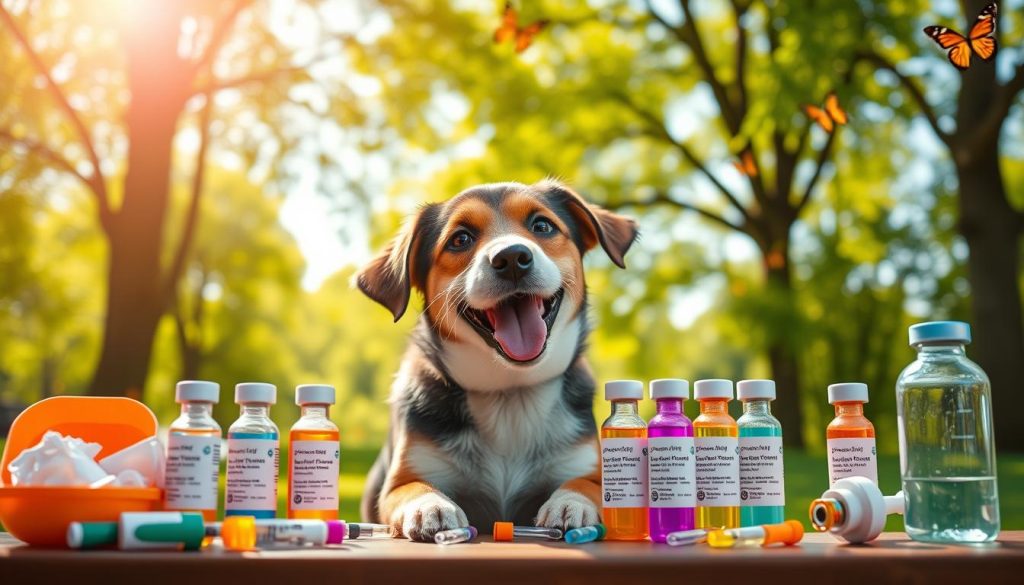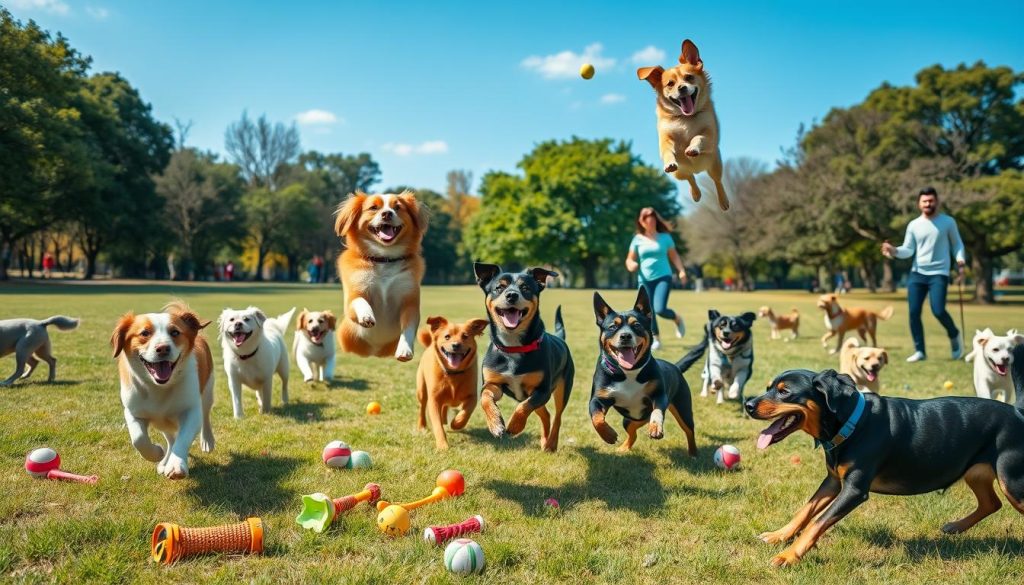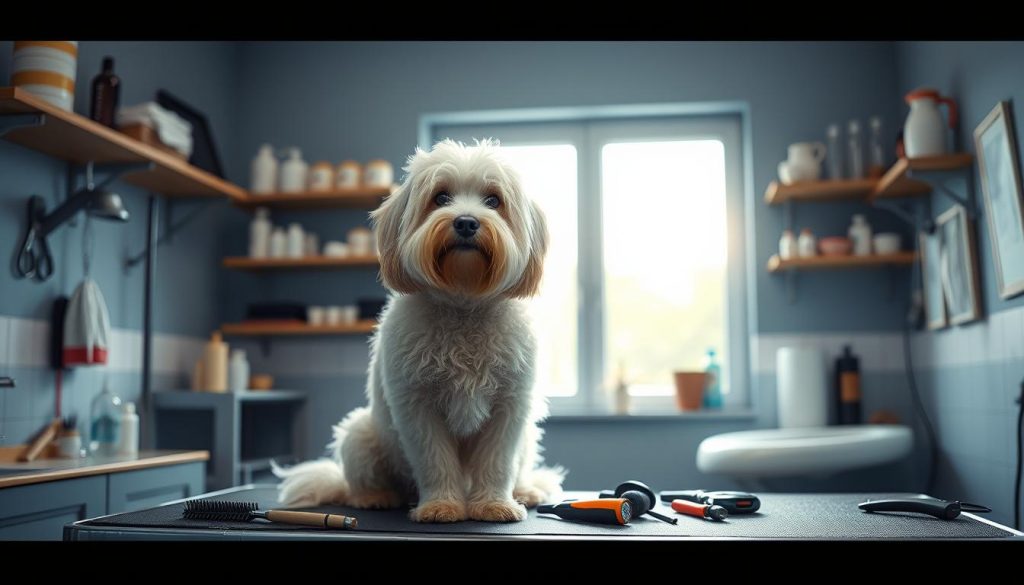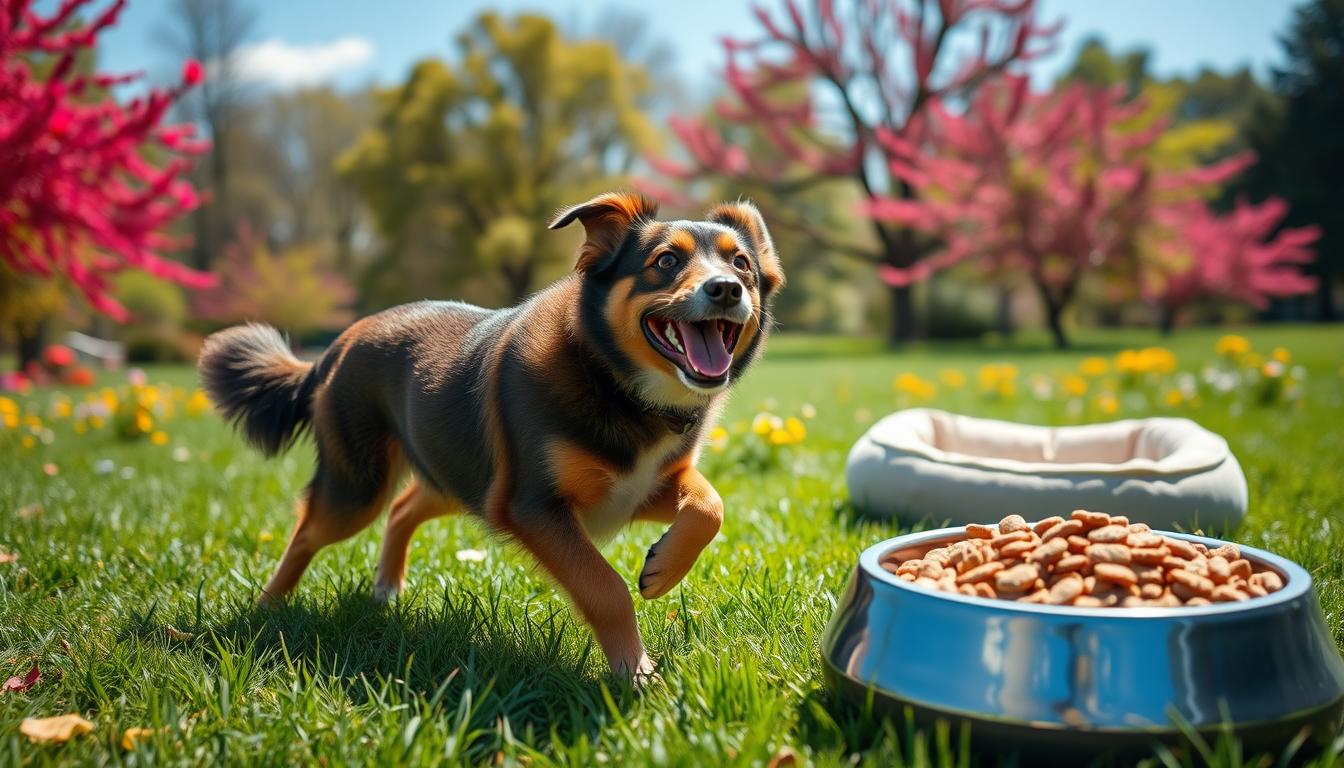As a passionate pet parent, I know how vital it is to keep our furry friends healthy. In this article, I’ll share key tips for your dog’s dog health. This includes the right dog nutrition, veterinary care, dog exercise, and grooming. Follow these guidelines to ensure your dog stays happy, healthy, and thriving.
Understanding Your Dog’s Nutritional Needs
It’s vital to give your dog a balanced diet for their health. Knowing what your dog needs is the first step to their happiness and well-being.
Choosing High-Quality Dog Food
Quality dog food is essential. Choose foods with natural ingredients, like protein, healthy fats, and vitamins. Stay away from fillers and artificial stuff that doesn’t help your dog.
Read labels and check the brand’s reputation. Talk to your vet or a pet nutrition expert to find the best food for your dog’s age, breed, and activity level.
Portion Control and Feeding Schedules
Right portion sizes are key for your dog’s weight and health. The right amount depends on their age, size, and how active they are. Follow the food packaging’s guidelines and adjust as needed.
Feeding at the same times every day helps your dog’s digestion and overall health. It keeps their routine regular and supports their natural rhythms.
| Dog Size | Recommended Daily Calories | Feeding Frequency |
|---|---|---|
| Small Breed (up to 20 lbs) | 20-40 calories per pound | 2-3 meals per day |
| Medium Breed (21-50 lbs) | 30-40 calories per pound | 2-3 meals per day |
| Large Breed (51-100 lbs) | 20-30 calories per pound | 2-3 meals per day |
By knowing your dog’s nutritional needs and feeding them right, you can help them live a long, healthy life.
Importance of Regular Veterinary Check-ups
As a responsible pet parent, it’s key to schedule regular vet visits for your dog. These visits are more than just for shots. They help keep your dog healthy and catch problems early.
At a vet check-up, your dog gets a full physical exam. The vet looks for any signs of illness or issues. They check your dog’s weight, vital signs, skin, coat, and teeth. This gives a clear picture of your pet’s health.
Regular vet care also helps set a health baseline for your dog. This way, the vet can spot any changes that might mean a health issue. Early action can make a big difference in your dog’s life.
- Preventive care to identify and address health issues early
- Monitoring of your dog’s weight, vital signs, and overall physical condition
- Establishment of a health baseline to detect changes over time
- Opportunity to discuss any concerns or questions with your veterinarian
Remember, your dog’s health is a team effort. By keeping up with vet visits and talking openly, you and your vet can keep your dog happy and healthy.
Dog Health: Staying Up-to-Date on Vaccinations

Keeping your dog healthy is a top priority for every pet parent. Ensuring their vaccinations are up-to-date is crucial. Dog vaccinations protect your furry friend from serious diseases.
Core and Non-Core Vaccinations Explained
There are two main types of dog health vaccines: core and non-core. Core vaccinations protect against serious diseases like parvovirus and rabies. Non-core vaccinations depend on your dog’s lifestyle and where you live.
- Core vaccinations: Parvovirus, distemper, adenovirus, coronavirus, and rabies
- Non-core vaccinations: Bordetella, Leptospirosis, Lyme disease, and canine influenza
It’s key to work with your vet to choose the right vaccinations for your dog. This depends on their age, health, and where they go. Keeping up with vaccinations is vital for your dog’s health and safety.
Exercising Your Furry Friend

Keeping your dog active is key for their health. Whether your dog is full of energy or calm, there are many ways to keep them active. Indoor and outdoor activities can help your dog stay fit and happy.
Indoor Activity Ideas
When it’s bad outside or you don’t have much space, try these fun indoor games:
- Fetch: A classic game that can be played in any open indoor area, from a hallway to a large room.
- Puzzle toys: Challenging your dog’s problem-solving skills with interactive puzzle toys can provide mental stimulation and physical activity.
- Tug-of-war: A great way to get your dog’s muscles working while bonding with them.
- Stair climbing: If you have stairs in your home, encourage your dog to run up and down, which can be a excellent low-impact workout.
Outdoor Activity Ideas
For dogs who love being outside, try these fun activities:
- Hiking: Exploring local trails or parks is a wonderful way to combine dog exercise with quality time together.
- Swimming: If your dog enjoys the water, a swim session can be a fantastic full-body canine fitness workout.
- Frisbee or ball games: Playing fetch or catching a frisbee in an open space is a fun way to get your pup’s pet activities and dog playtime on.
- Agility training: Consider enrolling your dog in an agility course, which combines dog enrichment with physical and mental challenges.
It’s important to match your dog’s exercise to their needs and energy. Start slow, watch how they react, and add more as they get stronger and more confident.
Grooming Essentials for a Healthy Coat

Keeping your dog’s grooming routine up to date is key for their health and looks. From regular baths to nail trims, good grooming keeps their coat and skin healthy.
Bathing for a Gleaming Coat
Bathing your dog is more than just cleaning them. It also keeps their skin healthy and their coat shiny. I suggest bathing your dog every 4-8 weeks. Use a gentle, pH-balanced shampoo made for dogs.
Don’t over-bathe your dog. This can take away the natural oils from their coat.
Brushing for a Tangle-Free Mane
Brushing your dog regularly is crucial for a healthy coat. Brush them a few times a week to avoid mats and tangles. This keeps their coat looking great and prevents skin problems.
Nail Trimming for Comfort and Safety
Pet nail trimming is a must in your dog’s grooming routine. Long nails can be painful and even harm their health. Trim your dog’s nails every 4-6 weeks, or as needed, to keep their paws healthy and comfy.
| Grooming Task | Frequency | Benefits |
|---|---|---|
| Dog Bathing | Every 4-8 weeks | Promotes healthy skin and coat |
| Brushing | Few times a week | Removes tangles, distributes oils |
| Nail Trimming | Every 4-6 weeks | Ensures comfort and paw health |
By adding these dog grooming steps to your pet’s routine, you keep them clean and their coat healthy. Remember, regular dog bathing and pet nail trimming are vital for your dog’s well-being.
Providing a Safe and Enriching Environment
As a responsible pet parent, it’s crucial to create a safe and fun space for your dog. Pet-proofing your home and adding enrichment activities are key. They help keep your pup happy and healthy every day.
Let’s start with pet-proofing your home. It’s important to remove hazards and make your home dog-friendly. This means securing cabinets, covering electrical cords, and keeping toxic substances away. Also, give your dog their own chew toys and set clear boundaries to protect your things.
It’s also vital to add enrichment activities to your dog’s daily routine. Things like puzzle toys and training sessions keep their mind active. Outdoor play and walks let them explore and get exercise.

